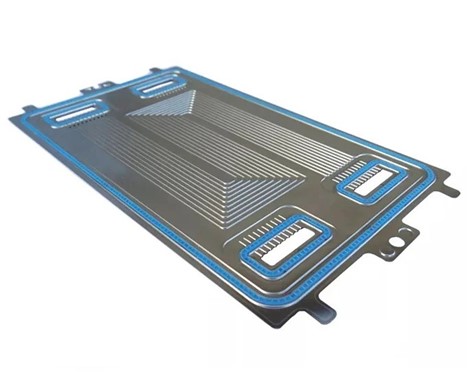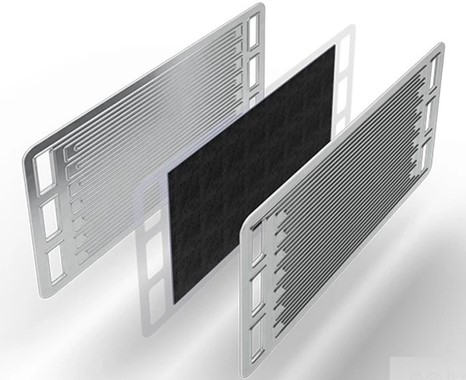It is essential to understand the function of bipolar plate in fuel cell to improve its performance, durability, and energy efficiency in the PEM systems. Many engineers and researchers today struggle with the task of flow and current uniformity optimization. The main functions of bipolar plates in PEM fuel cells include proper gas distribution, water and heat management. TMNetch is a leading expert and solution provider in advanced etching and manufacturing, which engineers precision products for more uniform and efficient performance, avoiding failures of various systems today.

Understanding the Function of the Bipolar Plate in a Fuel Cell
The function of bipolar plate in fuel cell, is the backbone of a PEM system. These plates serve as a physical and electrical bridge between each single cell; as well as gases, electrons, water, and heat. It is not a separator, but the main and equilibrium part of the system, which balances every but not least electrochemical reaction.
The function of bipolar plate in fuel cell stack, is to conduct electricity, to distribute gases, to balance water and heat, as well as to provide mechanical strength. I will try to find out all the functions of a plate and their involvement in safety, reliability, and long-term operation of power facilities. Below are the main functions of bipolar plates in PEM fuel cells

1. Electrical Conductivity and Current Flow
The bipolar plate facilitates effective electron flow from the anode of a cell through each bipolar plate to the cathode, where the current flows to the next unit. Voltage is also measured as an equivalent elapsed current and causes an amperage gap. In a highly efficient function of bipolar plate in fuel cell stack, this current flow is in balance with each electrode, and losses such as resistance occurring in each segment are low and minimal. Electricity and a bipolar plate powered by cells in place can be induced when the cells and fuel source are not the same. Conductivity holds the key to maintaining the temperature performance of the bipolar plate.
2. Gas Distribution and Flow
Gas manifolds or gases are the main functions of bipolar plates in PEM fuel cells. The channels or break circuit of the PEM fuel cells are used to distribute and control the flow of hydrogen and oxygen to the anode and cathode, respectively. They are used to maintain the same amount of contact and gas receivers with the catalyst layer and as such are used to prevent concentration of bonds as a loss in the function of bipolar plate in fuel cell.
3. Water Management and Humidity Regulation
During a fuel cell operation or flow sheet, water is produced at the operational aspect. It is a great function of bipolar plate in fuel cell to help with draining off the amount of water to avoid the membrane regularly causing shortages. If dry, it may also be used to allow the long cells down the stack to crack and break the cells.

4. Heat Transfer and Temperature Regulation
Heat is generated during the natural course of the electrochemical reaction. In a metal bipolar plate function in fuel cell is to evenly spread out and dissipate that heat. A fuel cell stack may use metals such as stainless steel or titanium, as they are an excellent conductor of heat; these metals do not develop hot spots, which may be experienced by other metals, and they remain uniformly hot once they are insulated from the cold electrode and endplate. In terms function of bipolar plate in fuel cell, this feature prevents hotspots on the plates that could damage the materials or reduce the cell’s efficiency.
5. Structural Support and Sealing Integrity
In addition, the function of bipolar plate in fuel cell is to provide structural support to the fuel cell stack by maintaining the proper compression level. The bipolar plate’s mechanical support can ensure that there are no leaks between the hydrogen and oxygen gases entering the fuel cell stack through its adjacent channels. Therefore, one can conclude that the function of bipolar plate in fuel cell stack is to become a mechanical support seal and help maintain the fuel cell’s performance under a range of operating pressures.
6. Corrosion Resistance and Durability
Moreover, metal bipolar plates are exposed to moisture, heat, and the reactive components of hydrogen and oxygen gases. For this reason, the plates require coatings that are corrosion-resistant and protective in nature. Due to material selection and multiple coatings, the metal bipolar plate function in fuel cell are expected to be used for the long term.

7. Flow Field Geometry Optimization
Finally, one of the main functions of bipolar plates in PEM fuel cells is their geometry in relation to the flow field. Alternative flow field designs, such as serpentine, interdigitated, and parallel, are intended to balance the airflow and get the best water clearance. Thanks to the more advanced patterning options, such as high-resolution photochemical etching, TMNetch achieves optimized designs where specific flow field functions, within a stack, achieve improved function of bipolar plate in fuel cell stack.
How Do Bipolar Plates Work in Fuel Cell Systems?
Many professionals ask, how do bipolar plates work in fuel cell applications? They operate as both electrical conductors and fluid distributors within each cell. Their applications include:
- Hydrogen Entry: Enters the anode side through the provided flow channels.
- Oxygen Supply: Oxygen or air enters through the cathode, where it mixes with the anode’s protons.
- Electron Flow: The metal bipolar plate function in fuel cell by transferring electrons to generate power.
- Water and Heat Removal: By managing by-products such as heat and water to maintain the application.
In summary, the main functions of bipolar plates in PEM fuel cells are the management of electrons, chemicals, and heat in a single structure.
Benefits of Optimized Bipolar Plate Design
It is apparent that when the function of bipolar plate in fuel cell systems is optimized, it directly enhances overall performance and lifespan. This section highlights mainstream benefits of developing and enhancing the design and manufacturing of these plates.

Key Advantages:
- Higher Efficiency: Reduced electrical resistivity leads to stronger energy conversion, underscoring the function of bipolar plate in fuel cell stack as ensuring consistent power delivery.
- Compact Structure: Overall density is improved through a streamlined design while maintaining tighter control of improved flow characteristics, which are the main functions of bipolar plates in PEM fuel cells.
- Resistance to Corrosion: Fully-functional coatings are applied to the surface to enhance conductivity while elongating the metal bipolar plate function in fuel cell systems’ lifespan.
- Improved Thermal Distribution: Even heat dissipation facilitates stronger temperature control and, consequently, overall stack lifespan.
- Lower Costs: Superior materials and alternative design options are developed for use in manufacturing at lower prices.
In conclusion, the above benefits demonstrate the importance of achieving a strong understanding of the main function of bipolar plate in fuel cell to create newer, better systems.
Common Challenges in Bipolar Plate Applications
Although we have already mentioned that technology is advanced, there surely are some issues that engineers will encounter when optimizing function of bipolar plate in fuel cell, including the possibilities mentioned below.
Top concerns:
- Corrosion and degradation of metal;
- Poor water removal due to a complex gas flow pattern.
- Complicated flow field design with lower distribution.
- Manufacturing of precise metal is too costly.
Addressing these problems may be impossible without high-precision etching and formation administered by such professionals as TMNtech. But here we would like to point out the aforementioned tendencies, which might become essential for improving the function of bipolar plate in fuel cell stack.
Why Choose TMNetch Bipolar Plate

Selecting TMNetch should be seen as one of the key choices for those who would like to improve the function of bipolar plate in fuel cell. In its turn, the etching and forming company has already presented a wide range of customers with the solutions designed to meet the goal. The key advantages of choosing TMNetch include:
- Quality Etching Offering: Utilizing flow fields of high precision.
- Custom Services: Tailored to PEM and solid oxide cells.
- Chemical coating: Corrosion and longevity.
- Comprehensive quality control: Long-term use and sustainability.
To sum up, it should be stated that the metal bipolar plate function in fuel cell of TMNetch provides performance and facilitates the business of clean energy and power systems.
FAQ
Q1: What is the function of a bipolar plate in a fuel cell?
The main purpose of the bipolar plates is to conduct electricity, assist in fluid distribution, and manage heat and water in individual cells.
Q2: How do bipolar plates help in fuel cells?
They support the entry of hydrogen and oxygen, lead the electrons to the circuits, and manage spot reactions to maintain the stack’s performance.
Q3: What is the reason for using metal bipolar plates in fuel cells?
The metal bipolar plate functions in a fuel cell because they are strong, corrosion-resistant, and far better at conducting than other types, allowing systems for high-performance fuel cells.
Final Words
In conclusion, the function of the bipolar plate in fuel cells is to maintain, seal, and lead gases, water, and heat in fuel cell stacks. At TMNetch, our state-of-the-art plates increase the importance of the main functions of bipolar plates in PEM fuel cells, and facilities receive greater energy density and reliability. If you are an expert in search of the best solution, we have a variety of available choices.
